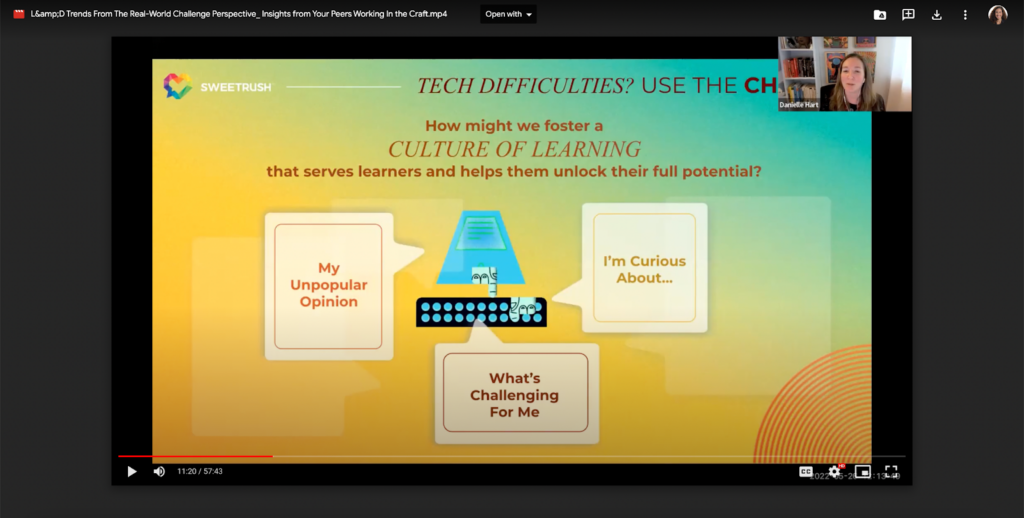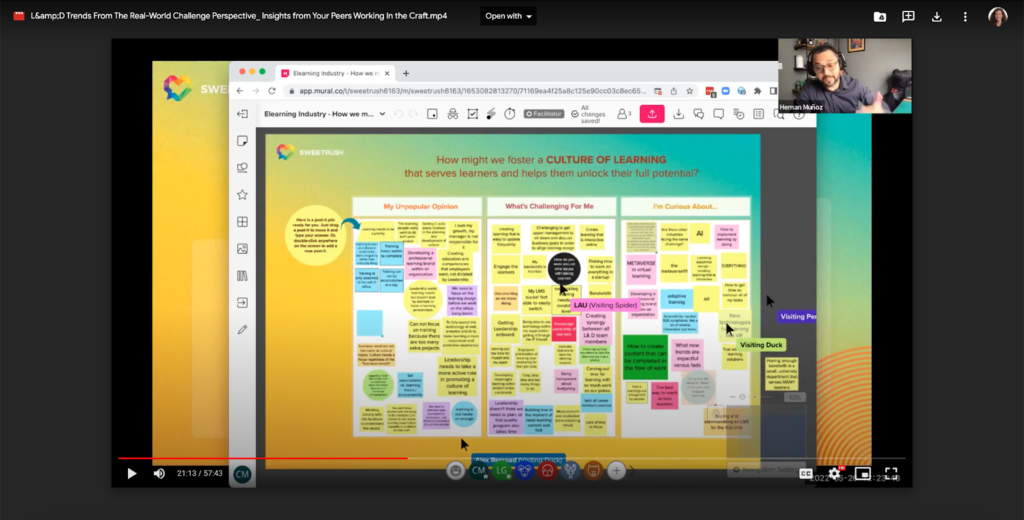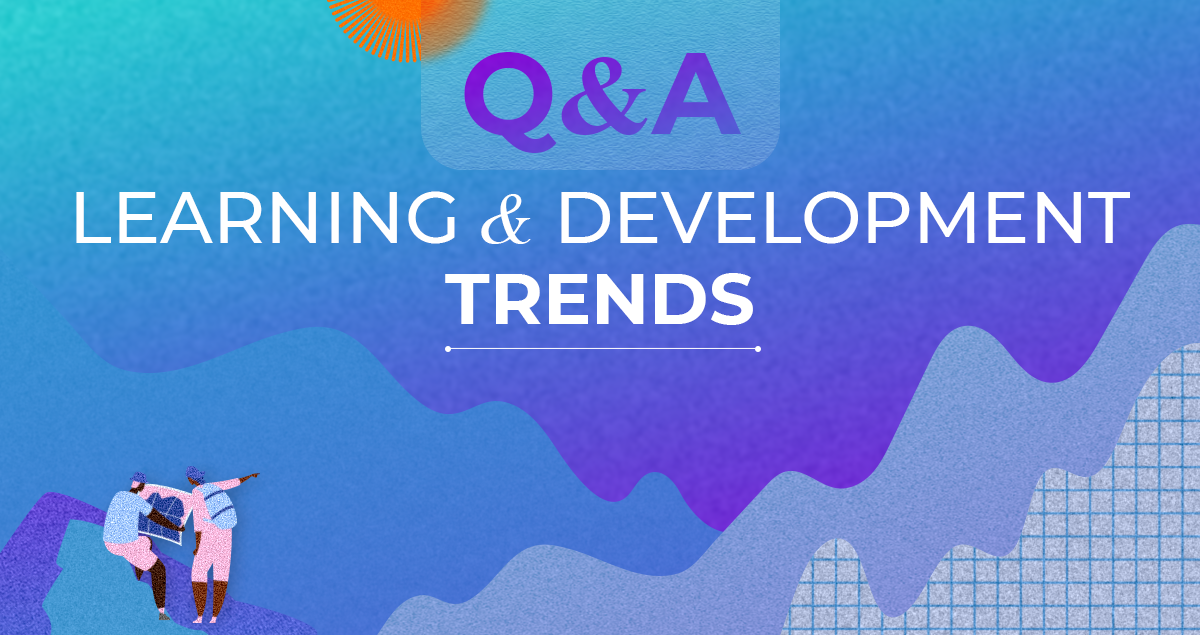In Learning and Development (L&D), it feels like we are always trying to catch up with all there is to know in this fascinating field. Augmented reality! The latest in eLearning! Leadership and cultural transformation! Organizational learning! Constant upskilling! Rightskilling! Just-in-time training! The list goes on. So we decided to curate the latest in learning and development trends for all of you.
After surveying learning leaders and professionals in the L&D field and analyzing the data, we compiled our comprehensive Learning and Development Trends Report: L&D Challenges, Life-Centered Solutions: Transforming Business & Unlocking Human Potential for L&D professionals like you to reference as you gear up to make your next strategic decisions. (You’re welcome! We actually had a lot of fun making it. Who knew stats and data could be so fun?)
In May, we shared the findings of our 2022 L&D Trends Report in our webinar L&D Trends From The Real-World Challenge Perspective: Insights From Your Peers Working In The Craft. In true SweetRush style, this wasn’t your typical webinar. Instead of lecturing participants on the findings of the report, our panel of thought leaders and experts invited participants to bring their real-life challenges to discuss and answer live! Panelists included Andrei Hedstrom (Cofounder & CEO), Annie Hodson (Director of Client Solutions), Hernán Muñoz (Creative Director Team Lead), Judi Kling (Senior Learning Experience Designer), and Danielle Hart (Director of Marketing).
Interactive Virtual Discussion
As we compiled the Trends Report, we noticed an overarching theme around building a culture of learning and specifically: How we might foster a culture of learning that serves learners and helps them unlock their full potential? For the interactive portion of the webinar, we posed this question to the audience and asked them to share their unpopular opinion, what’s challenging for them, and what they are curious about. The audience’s responses guided the question and answer session that followed.

The overall question of the interactive webinar focused on how to foster a culture of learning.

Webinar participants used virtual sticky notes to provide feedback on the following topics:
My Unpopular Opinion, What’s Challenging For Me, and I’m Curious About. The mural became a learning artifact for learners so they can reference it long after the event is finished. (Read more about what this means on page 34 of the Trends Report.)
Learning and Development Trends Q&A
We had a lively, engaged audience for the webinar who brought some tough questions about L&D trends to our panel. Here are the questions and insights they shared!
Q1. How do we motivate learners to take eLearning courses?
Judi: It revolves around the culture of learning. We’ve seen a shift from our clients to move away from learning as an event to learning as continuous. This goes beyond just motivating learners to take eLearning courses but also creating experiences that support them holistically.
We can pair those eLearning courses with cross-departmental projects, mentoring, and/or social support groups.
This way, the eLearning courses become a piece of a bigger whole, and then there’s the motivation to go and see what’s in that eLearning course.
Andrei: You need to understand the individual learner. And this is part of a larger question we see being asked of: How do you fully appreciate the effort it takes to understand your learners and build in the right level of support and awareness for your team? Who’s designing and developing these experiences?
Part of that awareness is understanding that there are going to be communications that are going to support learners coming to the training to begin with. That’s why some of our client-partners work with us to develop branding and communications.
That’s another layer of dialing into those learners—understanding what’s important to them and spending some time and resources, thinking about the sorts of things that are going to motivate them and get them to the training.
Q2. I don’t like my learning management system (LMS), and I am not able to switch. What should I do?
Judi: We’ve gotten really creative with LMSes and trying to get them to do things that you wouldn’t normally think would be possible. So we’ve had some social learning experiences that we’ve designed around training, and the groups go to the LMS and they click on a wrapper that looks very similar to a course. The LMS is tracking, but the learners can go outside of the LMS to do social learning.
There are techniques that we’ve used to maximize our client-partners’ LMS without limiting our learning solutions.
Hernan: If we’re limited to an LMS, maybe it’s time to think outside the box. What other things are available to us? Maybe there are things that you can do outside of the LMS. An LMS could be a legacy item, but it’s a great opportunity to think about communication, strategy, marketing, and ways to maximize what you have outside of the LMS.
Q3. Can we talk about screen fatigue?
Danielle: In the Trends Report, this concept of screen fatigue comes up a lot. At SweetRush, one of my favorite ways to learn is just to get together with a group of people who are really interested in the same topic and just chat about it.
Judi: We’ve had a lot of clients ask us about this over the past two years. It used to be that everybody wanted that “quick hit” in an LMS or eLearning course.
Now, we are looking at things like mentoring programs to put those experiences in with an eLearning to develop cross-departmental projects that might help this learning piece like social support groups or book clubs.
We have a book club going here around Learning and Development topics at SweetRush. We pick a book, read, come together, and learn together. It’s more of a social network and you’re learning. You’re doing what you need to do to advance your career, but it doesn’t feel like it. People are needing that right now.
Annie: With social learning, one of my favorite developments that I’ve seen in recent years is the shift of any kind of virtual instructor-led training (VILT) needing to be formal. It used to always have to be facilitated. It was: Here are the slides and facilitator guide. We have the activity, people come, and it’s this formal learning event.
I’ve seen a lot of our client-partners transitioning to this idea of a practice lab where people can come together and learn and not necessarily have a formal facilitator there.
Q4. How do you get leadership on board with learning initiatives?
Andrei: It takes time, resources, and awareness. There’s a really interesting discussion going on right now across cultures and organizations. There’s a collective awareness that if you can affect an individual’s potential, you can affect the organization’s potential.
Annie: People in L&D say, “Leaders don’t even know what they don’t know sometimes,” or “Leaders think they know a lot about education or learning or L&D but they don’t.”
At SweetRush, curiosity is an important part of our work and how we operate, and curiosity is good for all of those leaders too! Promote design thinking mindsets. Begin from a place of empathy and encourage leaders by saying, “All of us have our blind spots.”
We all can learn from what’s going on around us. Before we launch a big initiative, have we stopped to ask the learners? Have we stopped to conduct a focus group?
We have an activity that we do in our CoDesign workshops called The Talk Show where we talk to learners who are part of our target learning audience. We use this talk show format to ask them questions and get them sharing about what works, what doesn’t work, what they liked, what they wished for, and what was hard.
We let that empathy work ground the decisions that we make throughout the rest of the design process.
Q5. How do we create something cutting-edge but still make sure it’s accessible for learners of all types?
Hernan: When we think about cutting-edge technology, we can still make sure accessibility is at the forefront so that it can be inclusive of all learners. There’s a big trend in accessibility in the gaming industry right now, for example, which our industry can look to. There’s a very popular game called Elden Ring that has about 70 features for accessibility.
They are making games accessible in a variety of ways (color contrast, gameplay, mechanics of the controllers, audio settings). High-tech companies have heard the call to build more accessible products as well.
No matter the technology we are using, we can make learning that is accessible through inclusive design. At SweetRush, we are leading the way and working with several other companies to create accessibility standards for the eLearning industry.
The following are some questions that appeared in the chat that the panelists did not have the chance to answer:
Q6. Can you tell me more about the Talk Show format?
Hernan: Talk Show is a technique we use to interview our learner audience so that we can find out how they like to learn.
We call it Talk Show because, when we do our in-person CoDesign workshops, we set up a little stage area that looks like a talk show set. The facilitator (aka the talk show host) greets the guests (our learner audience) on stage with a warm welcome and proceeds to interview them. As an interviewer, I rely on active listening, reiterating what I heard from the client, asking clarifying questions and following my own curiosity at certain points.
Learn more about our Talk Show format in our Needs Analysis Playbook on page 38.
Q7. How long will it take for L&D professionals to become more of a stakeholder and have a seat at the table?
Andrei: It’s an incredible time to be in L&D. As L&D professionals, you’ve worked hard for decades to elevate the craft—once considered an afterthought—and now you’re being asked to create, contribute to, guide, and shape business strategy and transformation.
The pandemic may have fast-tracked this moment, but make no mistake, it was coming, supported by a growing body of evidence. Focusing on our people is the path to transform business and society for the better.
I’ve written an article about this in our Trends Report. Head to page 19 to read more.
Q8. Can you talk more about adaptive learning organizations?
Danielle: Adaptive learning organizations are able to quickly recognize change on the horizon and pivot to new strategies to support the needs of their business and the people they serve (leaders, employees, customers, etc.). They are collecting and analyzing the right data; they have frequent and direct communication with their stakeholders and audiences; and they make thoughtful (but not prolonged) decisions about restructuring, reorganizing, and reimagining their work.
During the pandemic, all learning organizations were forced to make rapid changes—the most obvious being the accelerated digital transformation of learning. Yet what changed and how smooth or painful that change was…every organization had its own unique experience. We’re fortunate to work with very large, global organizations, and it was impressive to see how a “big ship” can turn fast when there is a strong, unified culture and leadership. For example, many clients needed to shift resources when an area of the business was hit by the pandemic, and they collaborated with us on reskilling programs to help move that talent into other areas.
We also saw that our clients that have adaptive learning organizations were already assessing their digital learning portfolios by year two of the pandemic and looking to improve them. Continuous improvement and innovation are hallmarks of these organizations. I recommend Josh Bersin’s report on adaptive learning organizations to learn more!
Q9. What do you do when eLearning is not the employees’ preferred way of learning?
Judi: Here at SweetRush, we start with learner interviews to determine their feelings, needs, and wants around training. From there, we get what we call “audience insights.” These are statements that learners make, such as “I’m on the sales floor and don’t have time to sit down for eLearning.”
Then, we think about how insight will influence the learning solution. For the cases where eLearning is not the preference, we brainstorm alternative learning experiences that do fit in with their preferences. We think about questions such as: Where is our learner? In this place, how might they consume content? What does a learning experience look like to motivate them?
We’ve created just-in-time training where we place QR codes at key locations. The learner can scan the code and it brings up content in a variety of forms, such as a “how-to” document or a quick video. We’ve created podcasts for sales executives. This allows them to “train” while doing something else (driving to the client, sitting on an airplane, working out, and so on). We’ve also created sales onboarding where learners go on a physical scavenger hunt and collect customer service experiences from stores.
Just about anything you can imagine in terms of an experience can be leveraged for learning.
Thanks again to those of you who tuned in to the live webinar! If you’d like to watch the recorded webinar, you can do so here.
If you’re both excited by and a little overwhelmed with all the unfolding developments in L&D, you’re in great company. We all have questions, challenges, and insights. It’s how we approach them that makes the difference.
Reading our latest 2022 L&D Trends Report is a great starting place to orient yourself in this unique time in L&D. And reach out to start a conversation if you are finding yourself needing a partner for custom eLearning, L&D staffing, immersive technologies for learning, or transforming leaders and culture. We are here to help you with any of your people development and learning solutions.





